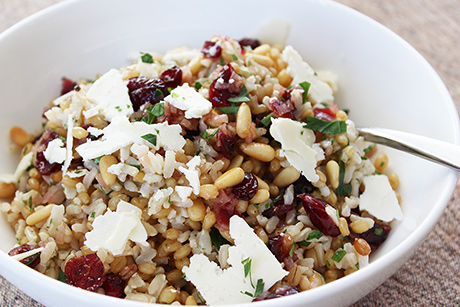
Whole grains come in all shapes, sizes, tastes and textures. With a myriad of B vitamins, fibre, iron, plant-based protein and minerals, each tiny grain delivers a hefty nutritional punch. A whole grain has its natural bran, endosperm and germ intact, which hold a good portion of its nutritional value.
The complex carbohydrates present in whole grains digest more slowly than refined versions, keeping blood sugar levels (and cravings) regulated for sustained energy. They’ve also been shown to reduce LDL (“bad” cholesterol), help to achieve and maintain a healthy weight, as well as lower heart disease and diabetes risk.
With whole grains, you’ve got many options not only in variety, but versatility in the kitchen, too. From breakfast to dinner and everything in between, there’s a grain out there for every time constraint, cooking level and craving. Here are the 10 most nutritious whole grains with tasty ways to add them to your daily diet.

Warm Brown Rice and Wheat Berry Salad Bowl
Millet
Not just for the birds, millet is a gluten-free whole grain containing amino acids, complex carbohydrates, fibre and a range of minerals. Its tiny, bead-like appearance makes it a whole grain alternative to couscous (refined white pasta), can be ground in your blender to make gluten-free flour for baked goods, and can be turned into a creamy grain main like this Millet, Lemon and Kale “Risotto.”
Quinoa
Quinoa’s superfood status is reputable, with complete plant-based protein containing all essential amino acids, fibre, iron and slow-digesting carbohydrates. The original fast-food, quinoa cooks up in 15 minutes and can be used in lieu of oats in porridge, tossed in a leafy salad, served as a simple side dish or as the main such as this cozy Avocado, Kale and Quinoa Salad.
Oats
Bran, rolled, steel-cut and whole groats are all the same grain presented in different ways. They’re high in soluble fibre, helping to lower cholesterol, improve digestion, help manage a healthy weight, reduce risk of cardiovascular disease and more. An everyday pantry staple that makes not only a fantastic warm breakfast cereal with rolled oats, but also risotto with steel-cut or pilaf with whole groats. They’re also star players in desserts, like this healthier recipe for Honey Oat Roasted Pears.
Farro (Spelt)
A popular grain in Italy long before it appeared on the everyday North American table, farro is an ancient wheat with a chewy, rice-like appearance that comes in three varieties; farro piccolo (einkorn), farro medio (emmer) and farro grande (spelt). Its ability to stay intact makes it the perfect pasta substitute in cold salads, like this veggie-packed Farro Salad with Radishes, Arugula and Feta.
Freekeh
A whole grain with a funny name, freekeh is a low-glycemic, naturally low-carbohydrate popular for its earthy taste and stellar nutritional profile. With four times the fibre of the same amount of brown rice, freekeh keeps you fuller for longer. It’s roasted, allowing it to work as a bold base for hearty pilafs. Try freekeh in a substantial bowl of greens and grains like this Carrot, Spinach and Freekeh Salad with Miso Vinaigrette.
Corn
Not often thought of as a whole grain, corn’s bad-boy health persona should be limited to the refined versions of itself (i.e. high-fructose corn syrup). Its standout nutritional features are lutein and zeaxanthin, carotenoids that help eyesight. As a whole food, corn is a unique grain in that it’s eaten fresh from the cob, as well as dried in the form of cornmeal and flour. For an elegant and healthy vegetarian entrée with corn, try this Veggie Ragu on Blue Cheese Polenta.
Brown Rice
Whole grain brown rice is a low-allergen, gluten-free whole grain high in B vitamins, selenium, fibre and slow-digesting carbohydrates. Many varieties of white rice can be readily found in whole grain brown rice such as basmati, short grain and long grain. Combined with a legume or bean, brown rice turns into a complete plant-based protein, as showcased in this recipe for Goat Cheese, Lentil and Brown Rice Rolls.
Black Rice
Inky-black with a slightly sweet, grapey taste, this dark-coloured whole grain is one of the highest sources of antioxidants in any food, even more so than most fruits and vegetables. It’s excellent as a side dish, used as a bed for curries or made into a healthy dessert like this Black Rice Pudding with Mango, Lime, Passion Fruit and Coconut.
Barley
Nutty, tender barley is best known for its role in wholesome soups and stews. Containing high amounts of B vitamins, magnesium, selenium and fibre, barley is an everyday, economical pantry staple. As it’s not gluten-free, barley isn’t suitable for those with celiac disease. Employ this pleasingly chewy whole grain as a complete-meal like this simple Slow-Cooker Bean and Barley Soup.
Wheat Berries
Unrefined whole wheat (used to make whole wheat flour) makes up wheat berries, which have a fruity, delicate flavour and a texture similar to barley. This slow-digesting, energy-boosting grain delivers a host of B vitamins, as well as fibre and magnesium. Use as a cold or warm breakfast cereal served with fruit and almond milk, or try this superfood-packed, double-grain Warm Brown Rice and Wheat Berry Salad Bowl.
